Book contents
- Frontmatter
- Introduction
- 1 Modes and means of literary production, circulation and reception
- 2 The Tudor era from the Reformation to Elizabeth I
- 3 The era of Elizabeth and James VI
- 4 The earlier Stuart era
- 5 The Civil War and Commonwealth era
- 21 Literature and national identity
- 22 Literature and religion
- 23 Literature and London
- 24 Literature and the household
- 25 Alternative sites for literature
- 26 From Revolution to Restoration in English literary culture
- Chronological outline of historical events and texts in Britain, 1528–1674, with list of selected manuscripts
- Select bibliography (primary and secondary sources)
- Index
- References
22 - Literature and religion
from 5 - The Civil War and Commonwealth era
Published online by Cambridge University Press: 28 March 2008
- Frontmatter
- Introduction
- 1 Modes and means of literary production, circulation and reception
- 2 The Tudor era from the Reformation to Elizabeth I
- 3 The era of Elizabeth and James VI
- 4 The earlier Stuart era
- 5 The Civil War and Commonwealth era
- 21 Literature and national identity
- 22 Literature and religion
- 23 Literature and London
- 24 Literature and the household
- 25 Alternative sites for literature
- 26 From Revolution to Restoration in English literary culture
- Chronological outline of historical events and texts in Britain, 1528–1674, with list of selected manuscripts
- Select bibliography (primary and secondary sources)
- Index
- References
Summary
The context
There was a war of words and images as well as a war of swords and muskets in mid seventeenth-century Britain, and it was a war fought with the same venom and the same determination. It was, to an even greater extent than the clash of arms, a war of religion or a series of wars of religion: the established Church of England was dismantled and the unity of the godly disintegrated. On the battlefield, the fighting followed existing good military practice, and the codes of honour were adhered to. There was no such restraint on the printed page: innovation, inventiveness, a spoliating invective was everywhere to be found. The heady cause of religious liberty was advanced with a freedom of form, syntax and vocabulary that startled, troubled and disturbed. This war of religion was waged across the period in a bewildering diversity of polemical strategies and forms in both prose and poetry.
On all sides, but perhaps especially on the Puritan side of the polemical exchanges, the religious writing in the period 1640–60 is a literary equivalent of the mid nineteenth-century opening up of the American West. It was frequently characterised by an exhilarating freedom, a high dependence on contingency, a rugged individualism, extraordinary improvisation and a central authority trying and largely failing to impose rules and inappropriate order. The most exhilarating (for us) and alarming (for many contemporaries) feature of this was the freedom that men and (more dramatically) women had to think unthinkable thoughts, to challenge those beliefs about the way the world was that previous generations had been incapable of thinking of questioning.
- Type
- Chapter
- Information
- The Cambridge History of Early Modern English Literature , pp. 664 - 713Publisher: Cambridge University PressPrint publication year: 2003
References
- 1
- Cited by

